"The Samhain Lantern", copyright Terrauh Barrett
Old village tales, superstitions and folklore regarding black cats abounded, and still exist in some communities to this day. Some European cultures consider a black cat to be a bad omen. The superstition of a black cat crossing your path being bad luck is very well known throughout North America and other parts of the world.
Samhain Flag
However, black cats didn't take on a really sinister aspect and become affiliated with evil until the Middle Ages, when the Christian Church began to associate black cats with women they accused of being witches. I had long known that black cats are considered to be familiars of witches, but I had no idea what that meant for the poor black cat!
By famous postcard maker Whitney
Some superstitions have it that a "familiar" - or familiar spirit - is an actual witch who has shape shifted into a different form. Others say that a familiar is a supernatural entity, perhaps an imp or minor demon in animal form, that shares a special bond with a witch.
Not that long ago, the scary duo of witch and black cat was regarded with fear and trepidation. Woe to anyone walking alone on a dark night if he spied a black cat lying in wait on a path. And worse still, a witch may be lurking nearby, seeking to cast a hex on the unwary traveler!
Artist Unknown
Familiars could take the shape of many different creatures, including mice, snakes, owls, hedgehogs, toads, hares, ferrets, lizards, bats, crows or ravens, black dogs and even "humanoid" creatures. But by far it is the black cat that maintains the most powerful association with witches. The fact that the cat - especially a black cat - received the most attention makes sense, because cats possess a particular unique personality. Cats are nocturnal by nature, and black cats blend in with the night. Their eyes glow in the dark, which could be considered a sign of evil. They also possess an unearthly wail.
"Hecate/Samhain", copyright Wendy Andrew.
Here the witch is associated with Hecate, the crone.
Here the witch is associated with Hecate, the crone.
Familiars were considered at least as dangerous as witches. They could spy or wreak havoc for their witch without being easily detected. Here are other things people said about familiars.
1. The main purpose of familiars is is to serve the youngest witches, providing protection for them as they come into their new powers.
2. They assist witches in their practice of magic, casting spells and hexes.
3. They act as intermediaries for the witch, carrying out her orders so that she won't have to be at the scene of the crime when the evil deed is done.
4. Hungarians believed that cats became familiars between the ages of 7 and 12 years.
5. It was possible to deliver the cat from the witch by making an incision on its skin in the form of a cross. (Woe the poor cat!)
Vintage Halloween Postcard, Raphael
Tuck and Sons of London
7. If a witch becomes human, her black cat will no longer reside in her house.
8. Witches grew an "unnatural nipple", with which they suckled their familiars. This was called a "witch's teat".
9. Witches turned themselves into cats or other animals in order to transport themselves to a sabbat (a midnight meeting) presided over by the devil.
10. A witch's cat came to be called a grimalkin. The Scottish goddess of witches was called Mither o'the Mawkins, a mawkin or malkin being either a cat or hare.
"Happy Samhain Kitten and Candle",
copyright Melissa A. Benson
John Richard Stephens explains in his book, The Enchanted Cat, how people twisted the concept of association with cats into something demonic and evil: "(It) began with the Catholic Church's persecution of religious groups, some of which worshipped the cat. In the 12th Century this persecution spread to splinter groups of the church itself, such as the Cathars, whom the church accused of worshipping the devil in the form of a cat. This led to stories of Satan's appearing at black masses as a cat."
Vintage Halloween postcard by artist Frances
Brundage, published by Tuck and Sons
Brundage, published by Tuck and Sons
The black cat suffered most in the areas of Europe that partook in the practice of witch trials, which started in the 13th Century. In 1233, Pope Gregory IX even went so far as to declare black cats to be evil, satanic creatures, leading to their widespread extermination. In 1484 Pope Innocent VIII issued a decree denouncing ALL cats and anyone who owned one! Inquisitor Nicholas Remy echoed this a century later when he said that all cats were demons. During this period priests presided over festivals where cats were burned by the hundreds.
Older women in the Middle Ages were almost always marginalized and lonely. Isolated from society, they turned to small animals for friendship. At one point during the witch hysteria in Europe, the mere possession of a black cat (or of a unusual pet like a frog, lizard or rat) was sufficient cause for investigation as a witch. Close animal companions were sometimes considered proof that a person was a witch!
"The Love Potion" by Ellen Morgan.
Though not a Halloween painting, it
shows a black cat as a witch's familiar.
Witch trials often produced "evidence" of a witch's teat on the body of the supposed witch - which could possibly have been a birthmark or growth. Regardless, any bodily imperfection on the suspect was immediately pronounced as evidence of a witch's teat.
Vintage Halloween Postcard -
Usually the cat is scary, not scared!
For several centuries these "witches" were rounded up, tried, and killed by burning, drowning or other violent methods, and their "familiars" were killed with them. In Europe and Britain over 200,000 supposed witches were executed. In New England there were over 2,000 cat-related witch trials. Millions of cats were destroyed, and the species was brought to the point of extinction.Of course today we know that most of the women considered to be witches were either falsely accused or were simply "cunning women", those who were well-versed in herbal lore and other folk remedies, which was sometimes considered witchcraft by overly superstitious folk.
Artist Unknown
Although we no longer burn and drown witches and their familiars, the poor black cat still can't catch a break! Did you know that black cats are the ones most often put to death in shelters? That's because they are the color of cat least adopted.
Wisely, shelters here in the United States will not adopt out black cats at Halloween and a few weeks prior and after, for fear they will be tortured, or used as "living decorations" for the holiday and then abandoned.
"Avoid grinning black cats on full green moon,
If your lover is true, he'll come back soon.
It breaks the charm, the witches scream
And never return, till next Halloween."
However, familiars have been depicted in a much more positive light in the Harry Potter movies, where the owls and other animals pair with the young spell casters to form a special bond. And modern day Wiccans and Neo-Pagans consider the black cat to be more like the Christian concept of a guardian angel. A Wiccan's familiar can be his or her closest companion, offering moral support, special knowledge, and/or physical healing.
So if you see a black cat (or a cat of any color) this Halloween/Samhain, offer it a big hug and give thanks that the cat survived as a species. Do not be afraid - be kind to the poor, abused, dreaded, maligned black cat!
"Hecate's Cauldron", Artist Unknown
Here, the witch has a black cat,
a hare and a raven!
~~~~~~~~~~~~~~~~~~~~~~~~~~~~~~~~
ADDED 10/24: Thank you so much, WOL, for your very insightful added information (see comments).



















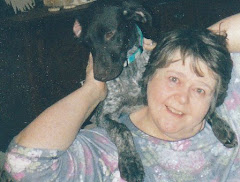



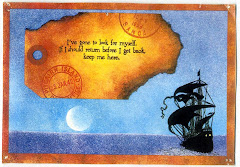














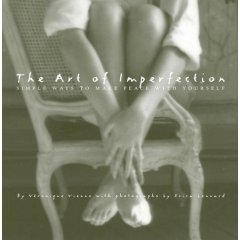


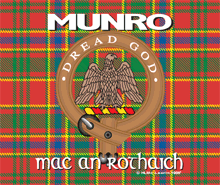
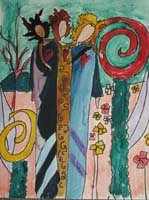

9 comments:
love this post!
black cats are one of my favorites and we save as many was we can!
Our little black cat was a sweet, saving grace and friend to us in a time of transition and she is still my favorite confidant. This was a delight, dear one. Blessings and thanks!
We have a big Samhain festival at the Chalice well gardens here in Glastonbury.
There's fire (naturally) music, dancing, story telling and food. I am really looking forward to it!
The wholesale destruction of cats during the witch hunts is credited with ensuring that the black death spread throughout Europe and Britain. Without the cats to keep their numbers in check, rats multiplied -- and so did the fleas that transferred the plague from rats to humans. It's no surprise that the plague spread like wildfire throughout the continent. There were also climatological factors in play as well. There was a "little ice age" from the beginning of the dark ages to shortly before the Renaissance with irregular and disrupted weather patterns that caused frequent crop failure and famine, all of which played into the witch hysteria. Another factor that is said to play into the witch hunts is the effort by male "educated physicians" to wrest the practice of medicine away from the "cunning women" and to do away with the "old wives' tales" in favor of "scientific" practices. However, judging from the medical theories and practices of the "physicians," you were more likely to survive your illness if you went to the "cunning women" because in most cases, the physicians' "scientific" cure was worse than the disease. -- yet another factor that contributed to the spread of plague.
WOL - Thank you so much for your insightful information!
Poor kitties. We have a black and white that is the most loving, affectionate animal ever.
Thanks for sharing all your knowledge and history!
great post Julie!
Leanne x
A wonderful informative post! We miss our little black cat, Shadow!
something in this post brougth BaBa Yaga to mind...I'm off to research if her cat (he was the real long-suffering hero in the stories!) was black..
Wonderfully informative and illustrated post! You always find the most wonderful pictures to illustrate your posts. And I love the idea of remembering to appreciate cats (black and otherwise) this Halloween! Thanks!
Post a Comment